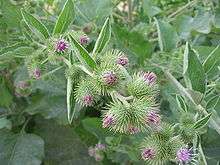Arctium minus
| Arctium minus | |
|---|---|
 | |
| Flower heads (capitula) | |
| Scientific classification | |
| Kingdom: | Plantae |
| (unranked): | Angiosperms |
| (unranked): | Eudicots |
| (unranked): | Asterids |
| Order: | Asterales |
| Family: | Asteraceae |
| Tribe: | Cynareae |
| Genus: | Arctium |
| Species: | A. minus |
| Binomial name | |
| Arctium minus (Hill) Bernh. 1800 not Schkuhr 1803 | |
| Synonyms[1] | |
|
Synonymy
| |
Arctium minus, commonly known as lesser burdock,[2] burweed, louse-bur, common burdock,[3] button-bur, cuckoo-button,[3] or wild rhubarb,[4] is a biennial plant. This plant is native to Europe,[5] but has become an invasive weed in Australia, North and South America, and other places.[6][7][8][9]
Characteristics: It can grow up to 1.5 meters (1 to 5 feet) tall and form multiple branches. It is large and bushy. Flowers are prickly and pink to lavender in color. Flower heads are about 2 cm (0.79 in) wide. The plant flowers from July through October. The flowers resemble and can be easily mistaken for thistles, but burdock can be distinguished by its extremely large (up to 50 cm) leaves and its hooked bracts. Leaves are long and ovate. Lower leaves are heart-shaped and have very wavy margins. Leaves are dark green above and woolly below. It grows an extremely deep taproot, up to 30 cm (12 in) into the ground.[10][11]
Lesser Burdock produces purple flowers in its second year of growth, from July to October. Outer bracts end in hooks that are like Velcro. After the flower head dries, the hooked bracts will attach to humans and animals in order to transport the entire seedhead. [12]
References
- ↑ The Plant List Arctium minus (Hill) Bernh.
- ↑ "BSBI List 2007" (xls). Botanical Society of Britain and Ireland. Archived from the original on 2015-02-25. Retrieved 2014-10-17.
- 1 2 USDA GRIN taxonomy
- ↑ USDA PLANTS information
- ↑ Altervista Flora Italiana, Lappola bardana minore Arctium minus (Hill) Bernh. includes photos plus European distribution map
- ↑ Flora of North America, Vol. 19, 20 and 21 Page 170 Common or lesser burdock, petite bardane, cibourroche, chou bourache, bourrier, Arctium minus (Hill) Bernhardi, Syst. Verz. 154. 1800.
- ↑ Biota of North America Program 2014 county distribution map
- ↑ Marticorena, C. & M. Quezada. 1985. Catálogo de la Flora Vascular de Chile. Gayana, Botánica 42: 1–157
- ↑ Atlas of Living Australia
- ↑ John W. Thieret, William A. Niering, and Nancy C. Olmstead. National Audubon Society Field Guide to North American Wildflowers, Eastern Region, Revised edition. Chanticleer Press, Inc, 2001. ISBN 0-375-40232-2
- ↑ Richard H. Uva, Joseph C. Neal, and Joseph M. Ditomaso. Weeds of the Northeast. Cornell University Press, 1997. ISBN 0-8014-8334-4
- ↑ Rose, Francis (1981). The Wild Flower Key. Frederick Warne & Co. pp. 386–387. ISBN 0-7232-2419-6.
External links
| Wikimedia Commons has media related to Arctium minus. |